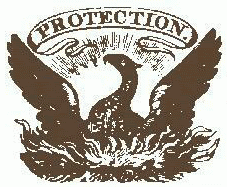Five hundred years ago, the people of the First Nations grew a crop that was used as a medicine for headaches, digestive problems and ailments of the lungs in children as well as adults.
It could be used in a powder form, or burned and inhaled. It was a well known medicine, and was so powerful and effective that the early settlers quickly adopted it and introduced it to
Today it is one of the most highly addictive and widespread drugs in the world. Ironically, this medicine's use now leads to diseases of the mouth, throat and lungs that it once treated and prevented.
Tobacco.
Monday, February 11, 2008
First Nations Legacy - "Miracle drug"
First Nations Legacy - "Independent Press"

One of our nation's oldest independent newspapers began in 1828. The Cherokee Phoenix was the first American Indian newspaper and is still published today.
The
Ultimately, the Cherokee and the
What's even more remarkable about the
Wadoh.
Monday, December 31, 2007
First Nations Legacy - "Name the place"
Can you guess the names of these well-known places from their translations?
1. Red people
2. Isolated thing in the water
3. Flat water
(answers at the bottom of this article)
You may never have heard of some of the cities with the greatest number of First Nations people, but these places natives can call home and find themselves in the majority. A rare experience these days.
Chinle, Arizona; Towaoc, Colorado; Red Lake, Minnesota; and White Swan, Washington are such towns, most being on the reservations. But there are neighborhoods in major cities where Native people of many tribes moved closer together after their forced relocation to the city from Native communities in the 1950s. Uptown in Chicago and S. Federal Blvd. in Denver are home to thousands of First Nations people. These urban areas are also home and shelter for Native cultures. They are an important part of these cities and to the people living there, no matter what race.
And now the answers:
1. Oklahoma is "red people" from the Choctaw language.
2. The Algonquin’s' "isolated thing in the water" is better known as Manhattan.
3. If you've ever driven through Nebraska, you will understand why the Otoe people named it "flat water."
Sunday, December 2, 2007
First Nations Legacy - "We are all related"

In our modern world, as researchers map genetic codes, we are finding out how very little difference there is among all life forms. We share more than 98 percent of genetic code with chimpanzees, and a surprising number of genetic code - 60 to 88 percent - with bees, chickens and mice.*
As people begin to think of the consequences of human consumption and changing global climate patterns, we might benefit from reminding ourselves that we are related to all life on Earth.
Aho - mitakuye oyasin.
*U.S. Dept. of Health and Human Services - National Institute of Health
Monday, November 19, 2007
Eli Painted Crow - A Native woman warrior's story of Iraq
EliPaintedCrow.org
Many thanks to Pura Fe for sending me this video. Yakoke.
First Nations Legacy - "Papoose"
Before horses and wheeled vehicles, mothers worldwide carried their babies using slings, straps and backpacks. When Europeans arrived on North American shores, however, they had shifted to putting babies in cradles and cribs and not carrying them around as often.
The term papoose is a Narragansett word for child. It is also commonly used to refer to baby carriers, backpacks and cradleboards.
American Indian women today typically keep their babies physically close and have continued many traditional child-rearing practices.
We now see women and men of all races carrying their babies close to them and going about their usual business, whether it’s hiking, shopping, washing the car… or going online to buy next season’s

